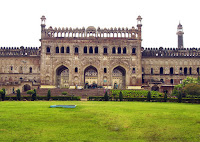After 1350 AD the Lucknow and parts of Awadh region have been under the rule of the Delhi Sultanate, the Mughal Empire, the Nawabs of Awadh, the East India Company and the British Raj. Lucknow has been one of the major centers of First War of Independence, participated actively in India's Independence movement, and after Independence has emerged as an important city of North India.
Until 1719, subah of Awadh was a province of the Mughal Empire administered by a Governor appointed by the Emperor. Saadat Khan also called Burhan-ul-Mulk a Persian adventurer was appointed the Nazim of Awadh in 1722 and he established his court in Faizabad near Lucknow.
Awadh was known as the granary of India and was important strategically for the control of the Doab, the fertile plain between the Ganga and the Yamuna rivers. It was a wealthy kingdom, able to maintain its independence against threats from the Marathas, the British and the Afghans. The third Nawab,Shuja-ud-Daula fell out with the British after aiding Mir Qasim, the fugitive Nawab of Bengal. He was comprehensively defeated in the Battle of Buxar by the East India Company, after which he was forced to pay heavy penalties and cede parts of his territory. The British appointed a resident in 1773, and over time gained control of more territory and authority in the state. They were disinclined to capture Awadh outright, because that would bring them face to face with the Marathas and the remnants of the Mughal Empire.

Lucknow's rise to growth and fame begins with its elevation as capital of Awadh by Nawab Asaf-Ud-Dowlah. He was a great philanthropist and gave Lucknow a unique and enduring legacy. The architectural contributions of these Awadh rulers include several imposing monuments. Of the monuments standing today, the Bara Imambara, the Chhota Imambara, and the Roomi Darwaza are notable examples. One of the more lasting contributions by the Nawabs is the syncretic composite culture that has come to be known as theGanga-Jamuni tehzeeb.
In 1798, the fifth Nawab Wazir Ali Khan alienated both his people and the British, and was forced to abdicate. The British then helped Saadat Ali Khan to the throne. Saadat Ali Khan was a puppet king, who in the treaty of 1801 ceded half of Awadh to the British East India Company and also agreed to disband his troops in favor of a hugely expensive, British-run army. This treaty effectively made the state of Awadh a vassal to the British East India Company, though it notionally continued to be part of the Mughal Empire in name until 1819.
The treaty of 1801 formed an arrangement that was very beneficial to the Company. They were able to use Awadh's vast treasuries, repeatedly digging into them for loans at reduced rates. In addition, the revenues from running Awadh's armed forces brought them useful revenues while it acted as a buffer state. The Nawabs were ceremonial kings, busy with pomp and show but with little influence over matters of state. By the mid-nineteenth century, however, the British had grown impatient with the arrangement and wanted direct control of Awadh.
In 1856 the East India Company first moved its troops to the border, then annexed the state, which was placed under a chief commissioner - Sir Henry Lawrence. Wajid Ali Shah, the then Nawab, was imprisoned, and then exiled by the Company to Calcutta. In the subsequent Revolt of 1857his 14-year old son Birjis Qadra son of Begum Hazrat Mahal was crowned ruler, and Sir Henry Lawrence killed in the hostilities. Following the rebellion's defeat, Begum Hazrat Mahal and other rebel leaders obtained asylum in Nepal.
Those company troops who were recruited from the state, along with some of the nobility of the state, were major players in the events of 1857. The rebels took control of Awadh, and it took the British 18 months to reconquer the region, months which included the famous Siege of Lucknow. Oudh was placed back under a chief commissioner, and was governed as a British province. In 1877 the offices of lieutenant-governor of the North-Western Provinces and chief commissioner of Oudh were combined in the same person; and in 1902, when the new name of United Provinces of Agra and Oudh was introduced, the title of chief commissioner was dropped, though Oudh still retained some marks of its former independence.
The province of Awadh was annexed by the East India Company in 1856 and placed under the control of a chief commissioner. In the Indian Rebellion of 1857 (also known as the First War of Indian Independence and the Indian Mutiny), the garrisonbased at the Residency in Lucknow was besieged by rebel forces. The famous Siege of Lucknow was relieved first by forces under the command of Sir Henry Havelock and Sir James Outram, followed by a stronger force under Sir Colin Campbell. Today, the ruins of the Residency, and the picturesque Shaheed Smarak offer reminiscences of Lucknow's role in the stirring events of 1857.
The city played an important role in both the First War of Independence and the modern Indian freedom struggle. Whether it was theLucknow Pact of 1916 or the Khilafat Movement, it brought the citizens on a united platform against the British rule. In the Khilafat Movement Maulana Abdul Bari of Firangi Mahal, Lucknow actively participated and cooperated with Mahatama Gandhi and Maulana Mohammad Ali.
In 1901, after remaining the capital of Oudh since 1775, Lucknow, with a population of 264,049, was merged in the newly formed United Provinces of Agra and Oudh.[18] However, it became the provincial capital in 1920 when the seat of government was moved from Allahabad. Upon Indian independence in 1947, Lucknow became the capital of Uttar Pradesh, the erstwhile United Provinces.




